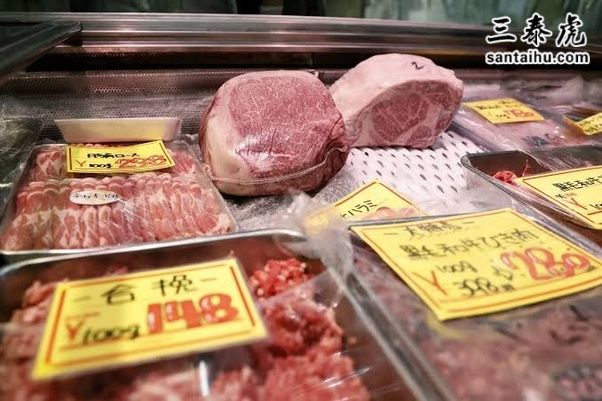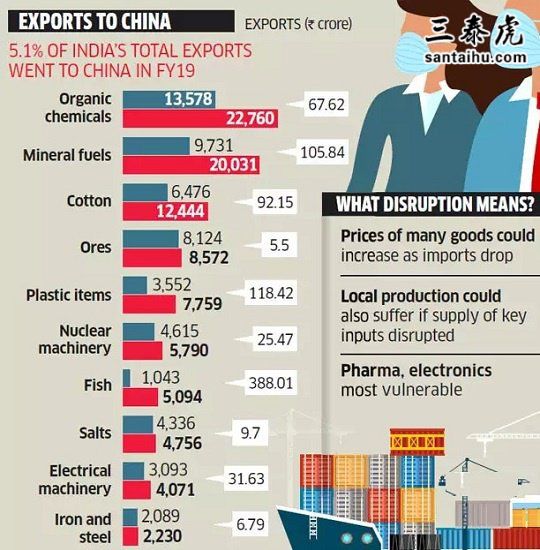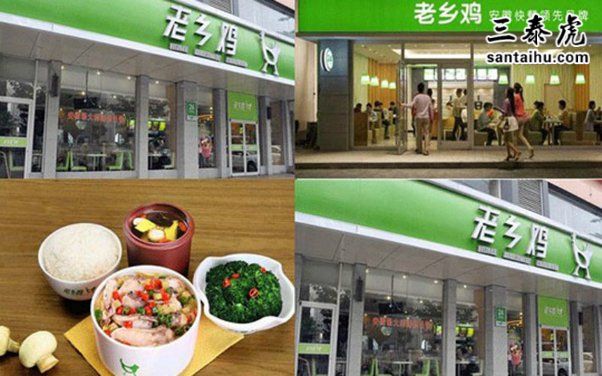Why does India still export food to China when its food production is less than half that of China (3.01/6.69 in 2020)? Aren't Indians hungry?
印度粮食产量(3.01 亿吨)尚不足中国(6.69 亿吨)的一半,为何仍要向中国出口粮食?印度民众难道不缺粮吗?
以下是Quora读者的评论:
Kanthaswamy Balasubramaniam
China grows twice the amount of food compared to India. China has slightly less population than India. Why is India a food exporter and China a food importer?
Let's see the numbers
China is estimated to have 1.403 Billion people and India around 1.436 Billion people
India produced a total of 218.9 Million Tons of Rice in 2024 against 214.4 Million Tons of Rice by China
India produced a total of 117 Million Tons of Wheat in 2024 against 141.1 Million Tons of Wheat by China
China produced 24 Million Tonnes of Chicken in 2024 and India 4.8 Million Tonnes of Chicken
China produced 54 Million Tonnes of Pork in 2024 and India 1.5 Million
China produced 7.1 Million Tonnes of Beef in 2024 while India produced 4.58 Million Tonnes
China produced 673 Billion Eggs in 2024 and India 138 Billion Eggs in 2024
China has a much higher yield than India though in Rice and Wheat
China on an average had a National Average Yield of 7.083 Tonnes per Hectare for Rice against 4.215 Tonnes per Hectare for India, and 5.99 Tonnes per Hectare for Wheat against 3.49 Tonnes per Hectare for India
中国的粮食产量是印度的两倍,人口却比印度略少,为何印度是粮食出口国,而中国是粮食进口国?
我们不妨看看具体数据。
据估算,中国人口约14.03亿,印度人口约14.36亿。
2024年,印度水稻总产量为2.189亿吨,中国为2.144亿吨;
印度小麦总产量为1.17亿吨,中国为1.411亿吨。
2024年,中国鸡肉产量为2400万吨,印度为480万吨;
中国猪肉产量为5400万吨,印度为150万吨;
中国牛肉产量为710万吨,印度为458万吨;
中国鸡蛋产量为6730亿枚,印度为1380亿枚。
不过在水稻和小麦的单产上,中国远高于印度:中国水稻全国平均单产为7.083吨/公顷,印度为4.215吨/公顷;中国小麦全国平均单产为5.99吨/公顷,印度为3.49吨/公顷。
Of course India doesn't consume Pork , so the huge difference must be ignored
Pork is a daily dish for Chinese
Also India has a large vegetarian population while China is completely non vegetarian with less than 0.15% of the population not consuming meat 14 days in a row (only 15 Chinese in 10,000 don't eat meat or fish for 14 days in a row and the main reason is economic )
So Chicken, Egg etc will be produced in far greater numbers
So why is China an Importer
Prosperity!!!!!
In the 1970s, The Average Chinese got meat, fish or poultry only 41 days in a year. They used Red Bean to make Artificial chicken meat
Today the Average Chinese gets Meat, Fish, Poultry 309 days in a year while the Poorest Chinese still eat Meat, Poultry or Fish Once in 4 days (Poorest of the Poor eat meat or fish or poultry 90 days a year)
The Chinese diet where TOFU / SOYBEAN formed 62% of Protein in 1985 is one where Red Meat forms 34.1% of Protein and all Meat, Poultry and Fish form 91% of Protein with Tofu contributing only 9% Protein
So while Pork production rose by 10.37% a year between 1985 to 2025 , Consumption rose by 17% a year
So every year China sees a 70% more growth in Consumers than Producers of Pork
So Today China imports Pork for around 23% of its needs, producing enough for 77% of its market

当然,印度民众基本不吃猪肉,所以两国在猪肉产量上的巨大差距可以先搁置不谈。
猪肉却是中国人的日常菜肴。
此外,印度有大量素食者,而中国几乎以肉食为主——连续14天不吃肉的人口占比不足0.15%(每1万名中国人中,仅15人会连续14天不吃肉或鱼,且主要原因是经济条件限制)。
因此,中国在鸡肉、鸡蛋等禽畜产品的产量上自然会远超印度。
那中国为何还是食品进口国呢?
答案是:经济繁荣带来的饮食升级!
上世纪70年代,中国人年均能吃到肉、鱼或禽肉的天数仅为41天,还会用红豆制作人造鸡肉。
如今,中国人年均食用肉、鱼、禽肉的天数已达309天;即便最贫困的群体,也能做到每4天吃一次肉、禽或鱼(极端贫困人群年均食用肉、鱼、禽肉的天数为90天)。
中国人的蛋白质来源也发生了巨变:1985年,豆腐、大豆提供的蛋白质占比达62%;而现在,红肉提供的蛋白质占比为34.1%,所有肉、禽、鱼提供的蛋白质占比更是高达91%,豆腐的贡献占比仅余9%。
因此,尽管1985年至2025年间中国猪肉产量年均增长10.37%,但猪肉消费量的年均增幅却达到17%。
这意味着,中国猪肉消费需求的年增长率比产量增长率高出70%。
如今,中国猪肉自给率为77%,约23%的猪肉需求需要通过进口来满足。
Chinas Beef Production is way lower than Consumption. Production rose by 3.10% a year, Consumption by 10.54% a year b/w 1985 and 2025
India unfortunately is still much poorer where a lot of people still can't get adequate meals
The Poorest Chinese still gets 1,332 Calories a day against only 828 Calories a day for an Average Poor Indian and 607 Calories for a day for an extremely Poor Indian
Eroding Agrarian Land
China only uses 11.17% of its Land for growing Arable crops
That's 95.2 Million Hectares falling by 9% in the last 15 years (2008–2023)
India uses 51.38% of its Land for growing Arable crops
That's 160 Million Hectares, rising by 31% in the last 15 years (2008–2023)
中国的牛肉产量远低于消费量。1985 年至 2025 年间,牛肉产量年均增长 3.10%,而消费量年均增幅高达 10.54%。
遗憾的是,印度目前仍相对贫困,许多民众仍无法获得充足的食物。
中国最贫困群体日均卡路里摄入量仍有 1332 千卡,而印度普通贫困民众日均仅 828 千卡,极端贫困民众更是只有 607 千卡。
耕地面积不断缩减
中国仅将 11.17% 的国土面积用于耕地种植,耕地总面积为 9520 万公顷。2008 年至 2023 年这 15 年间,中国耕地面积减少了 9%。
印度则将 51.38% 的国土面积用作耕地,耕地总面积达 1.6 亿公顷。在 2008 年至 2023 年的 15 年间,印度耕地面积增长了 31%。
This is due to faster modernization and industrialization of China than India
So China needs more food
In the past 10 years - Chinese exports of Expensive Food like Fruits, Walnuts, Lobsters, Caviar, Wagyu, Kobe etc have risen between 229% and 3,863%
India isn't seeing that kind of prosperity yet
However India is also seeing decent prosperity
Korean Noodles Brand confirmed a 88% growth from 2017–2024
In 1987, 71% Households used Dalda for majority of their cooking and today 100% Households use Ghee, EVEN THE POOREST
In 1995, Indian Per Capita Milk Consumption was a mere 98.5 grams a day and now it's 472 grams a day revealing a 500% growth in 30 years in Milk Consumption
这背后的原因是中国的现代化与工业化进程比印度更快,因此对粮食的需求也更大。
过去10年间,中国在高端食品出口领域增长显著——水果、核桃、龙虾、鱼子酱、和牛、神户牛肉等产品的出口增幅介于229%至3863%之间。
印度目前尚未实现这种程度的繁荣,但也正处于稳步发展阶段。
韩国方便面品牌的数据显示,2017年至2024年间,其在印度市场的销量增长了88%。
1987年时,71%的印度家庭主要使用人造黄油(Dalda)烹饪;而如今,所有印度家庭(包括最贫困的家庭)都用上了酥油(Ghee)。
1995年,印度人均日饮奶量仅为98.5克;如今这一数字已达472克,意味着30年间印度人均奶消费量增长了5倍。
Qi Chen
Because India has to balance its trade somehow.
China can import lots of food and raw material because it has a huge trade surplus in manufacturing, so China balance the trade via importing lots of raw material and food.
BTW, this is why lots of English audience believe China must have food import to survive, because China does import a lot of food.
The reality, however, is that China has a per capita daily calorie intake of 3490 kcal (as of 2023), it is the second highest in all major economies (only lower than US’ 3600kcal) and much much higher than Japan, South Korea, India, etc.
So China’s domestic production is totally fine to meet the minimal weight maintaining requirement (which is about 1800 kcal per day for adult male human).
On the other hand, the Chinese likes to eat well, so they import a huge variety of fruit, meat, beans, etc. There is a joke in China, that if you go to US or UK and ask for the local signature dish, they are going to take you either to a French or Mexcan restaurant.
India, however, doesn’t have a powerful manufacturing industry like China, but its people do still want modern appliances, so India has a major trade deficit in manufacturing sector. India also isn’t very resource rich, so the only thing India can go for is agriculture export.
这背后其实是印度对贸易平衡的无奈考量。
中国之所以能大量进口粮食与原材料,核心在于其制造业拥有巨额贸易顺差——通过进口大量原材料和粮食,中国得以实现整体贸易平衡。
顺带一提,这也正是许多英语受众误以为中国“必须靠进口粮食才能生存”的原因,毕竟中国的粮食进口量确实可观。
但事实并非如此:截至2023年,中国居民人均每日卡路里摄入量已达3490千卡。在主要经济体中,这一数据仅次于美国(3600千卡),远超日本、韩国、印度等国。
可见,单论满足基本生存需求(成年男性每日约需1800千卡维持体重),中国国内粮食产量完全绰绰有余。
只不过中国人追求更高品质的饮食,因此会大量进口各类水果、肉类、豆类等。国内甚至流传着一个有趣的说法:若你在美英两国询问当地特色菜,当地人多半会带你去法式餐厅或墨西哥餐厅。
反观印度,它没有像中国这样强大的制造业,民众却同样渴望现代化家电,这导致印度制造业长期处于巨额贸易逆差状态。加之印度自身资源并不丰富,出口农产品便成了它为数不多的选择。
Bill Chen
Well India as the world's number 1 rice exporter and number 2 beef exporter are two of the most vexng contradictions in modern India.
Only Brazil exports more beef than India.
This despite India consistently ranking near bottom of the world hunger index, with Indian officials complaining calorie consumption baselines should be lowered due to the sedentary nature of urbanized living.
India generates an agricultural trade surplus, but it has been narrowing in recent years due to increased demand for edible oil, legumes (pulses) and fruit and nuts.
India can benefit from a change in the crop mix, especially beef production which is resource intensive. But change is hard to drive in a nation where 600–800m indians depend on grain subsidies. Yet live births remain healthy, drop 5% from 24m in 2019 to 23m in 2024, driving a change in tfr from 2.2 to 1.9.
India marches to its own drumbeat.
印度身为全球第一大稻米出口国与第二大牛肉出口国,这两大身份堪称现代印度最令人费解的矛盾现象之一。
全球范围内,仅有巴西的牛肉出口量超过印度。
然而与之形成鲜明对比的是,印度在世界饥饿指数中的排名常年垫底。印度官员甚至称,鉴于城市化进程中民众生活愈发久坐不动,应当下调卡路里摄入基准线。
印度的农产品贸易虽仍保持顺差,但近年来由于食用油、豆类、水果及坚果的需求激增,这一顺差规模已在不断收窄。
调整作物结构或许能为印度带来益处,尤其是牛肉生产——这类产业对资源消耗极大。但在印度,6亿至8亿民众依赖粮食补贴生活,推行这样的变革难度极大。不过值得关注的是,印度人口出生率正稳步下降:从2019年的2400万降至2024年的2300万,降幅达5%,这也使得总和生育率(TFR)从2.2降至1.9。
印度始终在走着一条属于自己的独特道路。
Ramkumar Natarajan
China is deficient in the natural resources, water and arable land. China's per capita freshwater resources is only 2,220 cubic meters, about 30 percent of the global average. For India the data for the year 2017 was 1,427.5 cubic meters.
Arable land (hectares per person) in China was reported at 0.08579 in 2018, according to the World Bank, which is only 40 percent of the world average. The value for Arable land (hectares per person) in India was 0.118 as of 2016.
Despite these constraints, China has succeeded in producing one fourth of world’s grain and feeding one fifth of world’s population with 8.8 percent of world arable land, which is great achievement in pursuit of food and nutrition security not only in China but also in the world. Currently, China ranks first in the world in terms of the production of cereals, cotton, fruit, vegetables, meat, poultry, eggs and fishery products.
Although China's agricultural output is the largest in the world, about 75 percent of China's cultivated area is used for food crops. Rice is China's most important crop, raised on about 25 percent of the cultivated area. Wheat is the second most-prevalent grain crop, grown in most parts of the country. Corn, oats and millet are also grown in China.
Both India and China are among the world’s top three producers of important crops such as rice, wheat, cotton and maize, but China produces much more from each hectare of land than India does.
中国在自然资源、水资源与耕地面积方面均存在短板。中国人均淡水资源仅为2220立方米,约为全球平均水平的30%;而印度的这一数据为1427.5立方米。
根据世界银行数据,2018年中国人均耕地面积(以公顷计)为0.08579,仅相当于世界平均水平的40%;2016年,印度的人均耕地面积为0.118公顷。
尽管面临如此制约,中国仍凭借全球8.8%的耕地,成功产出了全球四分之一的粮食,养活了全球五分之一的人口。这不仅是中国在粮食与营养安全领域的卓越成就,更对全球粮食安全有着重要意义。目前,中国的谷物、棉花、水果、蔬菜、肉禽、蛋类及水产品产量均位居世界首位。
即便中国是全球农业产出最高的国家,其约75%的耕地仍用于粮食作物种植。水稻是中国最重要的农作物,种植面积约占总耕地的25%;小麦是第二大粮食作物,在全国大部分地区均有种植;此外,中国也种植玉米、燕麦与小米等作物。
中印两国均跻身水稻、小麦、棉花、玉米等重要作物的全球前三生产国之列,但中国每公顷耕地的产量远高于印度。
Since 1949, China lost one fifth of its arable land to urbanisation and industrialisation and currently only about 10 to 15 percent of the land is left good for agriculture, compared to 50 percent in India. India possesses 9.22 percent of the global arable land.
Rapid economic growth has fueled dramatic reductions in China’s below poverty line population and their spending on food has gone up with new food habits.
Over the past several decades, China’s grain consumption has more than tripled from 125 million metric tons in 1975 to 420 million tonnes in 2018, owing to improvement in living standards.
With regard to meat products, China has witnessed an astronomical increase in consumption. In 1975, China consumed a mere 7 million tonnes of meat. That figure had grown to 86.5 million tonnes by 2018, making it the largest meat consumer in the world.
1949年以来,中国有五分之一的耕地因城镇化与工业化建设被占用,目前适宜农业种植的土地仅余10%至15%;而印度的这一比例为50%,且其耕地面积占全球总量的9.22%。
经济的快速增长大幅减少了中国的贫困人口数量,随着饮食习惯的转变,民众在食品上的开支也随之增加。
过去数十年间,得益于生活水平的提升,中国的粮食消费量增长逾两倍——从1975年的1.25亿吨增至2018年的4.2亿吨。
在肉类消费方面,中国的增幅更是惊人:1975年,中国肉类消费量仅为700万吨;到2018年,这一数字已攀升至8650万吨,使中国成为全球最大的肉类消费国。

Balachandran Krishnamoorty
Indians are not hungry. The FCI holds 817 lakh metric tonnes of food grains in its warehouses. And many more lakh tonnes of food grains are in the pipeline.
印度民众并不缺粮。印度食品公司的仓库中目前储存着 8170 万吨粮食,此外还有数百万吨粮食正在运输或筹备途中。
Kanthaswamy Balasubramaniam
The Golden Rule of Deng iao was People with Full Bellies tend to be less revolutionary and more reasonable
The Sign of any Prosperous Country is that They eat very well
China is one such Country. The Sign of their Prosperity is such that their Per Capita Consumption of Food has risen by 85% from 1976 to Present while the Population has risen by just 17%.
Likewise their Per Capita Wasted Food has risen from 39.02 Kg in 1976 to 81 Kg in 2020 indicating further prosperity.
肚子吃饱的人,往往不那么倾向于激进,思考问题也更理性。
判断一个国家是否繁荣,有一个直观的标志——国民饮食条件是否优越。
中国正是这样一个国家。其繁荣的佐证之一是:从1976年至今,中国人口仅增长17%,人均食品消费量却提升了85%。
同样能体现其繁荣程度的是人均食品浪费量:1976年为39.02公斤,到2020年已增至81公斤,这一增长从侧面反映出生活水平的进一步提升。
This means China has to import more food than it produces especially given that the Land under Cultivation is just 15%.
China exports Soybeans from Brazil and Australia, Corn from Australia, Wheat from Australia, Butter, Cheese, Cream , Chevon and Cut Meats from New Zealand, Cured Meats, Cheese etc from Europe and Rice from Bangladesh.
Normally Chinese Imports of Food from India are minimal but in 2020 - China lost 21% Production due to Floods which meant they had to import more food. Thus they placed orders with India for Rice and a few other products.
China has lesser arable land and a richer population - which means they will tend to eat better and thus China will need more Imports of food which is why they are spending more than $ 41 Billion in Farms across the world to produce Soybeans (Kenya, Ethiopia), Tea (Ethiopia), Pork & Beef (Argentina, Canada)

这意味着中国的食品进口量需要超过国内产量,尤其是考虑到中国目前可耕种土地仅占国土面积的15%。
中国的食品进口来源广泛:从巴西和澳大利亚进口大豆,从澳大利亚进口玉米与小麦,从新西兰进口黄油、奶酪、稀奶油、山羊肉及分割肉,从欧洲进口腌肉、奶酪等,还从孟加拉国进口大米。
通常情况下,中国从印度进口的食品量极少,但2020年中国因洪涝灾害导致粮食减产21%,不得不增加食品进口量,因此向印度订购了大米及其他部分农产品。
中国耕地面积较少,且国民财富水平较高——这意味着民众对饮食品质的要求更高,因此中国对食品进口的需求会持续增加。也正因为如此,中国在全球范围内投资了超过410亿美元用于农场建设,例如在肯尼亚、埃塞俄比亚种植大豆和茶叶,在阿根廷、加拿大发展猪肉和牛肉产业。
此文由 三泰虎 编辑,未经允许不得转载!:首页 > 印度看中国 » 印度粮食产量尚不足中国的一半,为何仍向中国出口粮食,印度民众难道不缺粮吗
 2025年世界人口状况报告,印度人口预计达14.6亿,中国人口为14.1亿
2025年世界人口状况报告,印度人口预计达14.6亿,中国人口为14.1亿 印度女记者:法国2023年面临人口危机,中国人口连续第二年减少
印度女记者:法国2023年面临人口危机,中国人口连续第二年减少 莫迪政府:印度人口是13.9亿,没有超过中国人口
莫迪政府:印度人口是13.9亿,没有超过中国人口 印度人口将超过中国,这对全世界意味着什么
印度人口将超过中国,这对全世界意味着什么